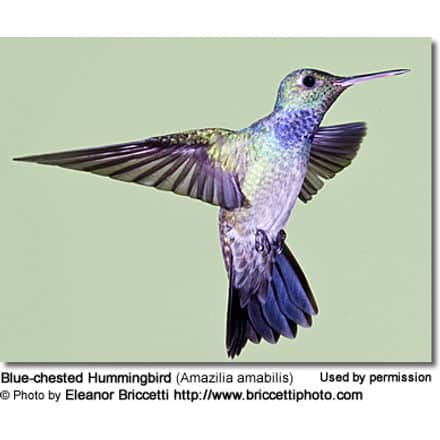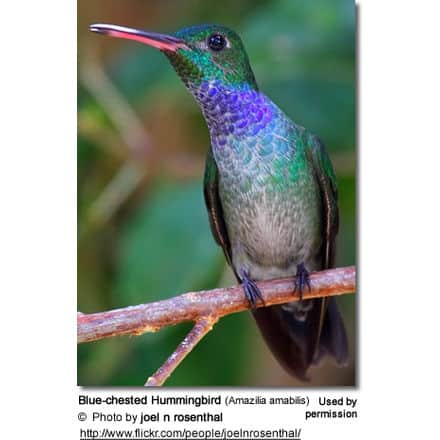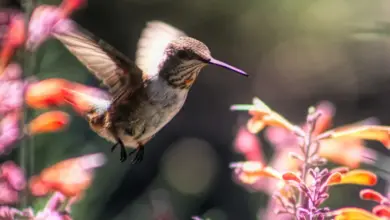Blue-chested Hummingbirds (Amazilia amabilis)
The Blue-chested Hummingbirds (Polyerata amabilis / Amazilia amabilis) – also known as are Blue-breasted or Beryl-crowned or Lovely Hummingbirds – are Central and South American hummingbirds that occur naturally in Honduras, Nicaragua, Costa Rica, Panama, Colombia and Ecuador; where they occur in subtropical or tropical moist lowland forests and heavily degraded forest.
Some authorities consider the Blue-chested Hummingbird conspecific (one species) with the Charming Hummingbird or Beryl-crowned Hummingbird (Amazilia decora) – as they look very much alike.


Subspecies and Distribution
- Polyerata / Amazilia amabilis amabilis (Gould, 1853) – Nominate Species
- Found in northeastern Nicaragua to north-central Colombia and Ecuador west of the Andes; possibly also in southeastern Honduras.
- Found along the Pacific slope from southwestern Costa Rica to western Panama.
Alternate (Global) Names
Spanish: Amazilia Amable, Amazilia pechiazul … Italian: Amazilia pettoblu … French: Ariane aimable … German: Blaubrustamazilie … Latin: Amazilia amabilis, Polyerata amabilis … Czech: Kolibrík modroprsý, kolib?ík modroprsý … Danish: Blåbrystet Amazilie … Finnish: Sinirintakolibri … Japanese: emerarudohachidori … Dutch: Blauwborstamazilia, Blauwbuikamazilia … Norwegian: Blåbrystkolibri … Polish: szmaragdzik modrowstegi, szmaragdzik modrowst?gi … Russian: ???????????? ???????? … Slovak: kolibrík modroprsý … Swedish: Blåbröstad smaragd
Nesting / Breeding
Hummingbirds are solitary in all aspects of life other than breeding; and the male’s only involvement in the reproductive process is the actual mating with the female.
They neither live nor migrate in flocks; and there is no pair bond for this species. Males court females by flying in a u-shaped pattern in front of them. He will separate from the female immediately after copulation.
One male may mate with several females. In all likelihood, the female will also mate with several males. The males do not participate in choosing the nest location, building the nest or raising the chicks.
The female is responsible for building the cup-shaped nest out of plant fibers woven together and green moss on the outside for camouflage in a protected location in a shrub, bush or tree.
She lines the nest with soft plant fibers, animal hair and feather down, and strengthens the structure with spider webbing and other sticky material, giving it an elastic quality to allow it to stretch to double its size as the chicks grow and need more room. The nest is typically found on a low, thin horizontal branch.
The average clutch consists of two white eggs, which she incubates alone, while the male defends his territory and the flowers he feeds on. The young are born blind, immobile and without any down.
The female alone protects and feeds the chicks with regurgitated food (mostly partially-digested insects since nectar is an insufficient source of protein for the growing chicks). The female pushes the food down the chicks’ throats with her long bill directly into their stomachs.
As is the case with other hummingbird species, the chicks are brooded only the first week or two, and left alone even on cooler nights after about 12 days – probably due to the small nest size. The chicks leave the nest when they are about 20 days old.

Diet / Feeding
The Blue-chested Hummingbirds primarily feed on nectar taken from a variety of brightly colored, scented small flowers of trees, herbs, shrubs and epiphytes.
They favor flowers with the highest sugar content (often red-colored and tubular-shaped) and seek out, and aggressively protect, those areas containing flowers with high energy nectar.
They use their long, extendible, straw-like tongues to retrieve the nectar while hovering with their tails cocked upward as they are licking at the nectar up to 13 times per second. Sometimes they may be seen hanging on the flower while feeding.
Many native and cultivated plants on whose flowers these birds feed heavily rely on them for pollination. The mostly tubular-shaped flowers actually exclude most bees and butterflies from feeding on them and, subsequently, from pollinating the plants.
They may also visit local hummingbird feeders for some sugar water, or drink out of bird baths or water fountains where they will either hover and sip water as it runs over the edge; or they will perch on the edge and drink – like all the other birds; however, they only remain still for a short moment.
They also take some small spiders and insects – important sources of protein particularly needed during the breeding season to ensure the proper development of their young.
Insects are often caught in flight (hawking); snatched off leaves or branches, or are taken from spider webs. A nesting female can capture up to 2,000 insects a day.
Males establish feeding territories, where they aggressively chase away other males as well as large insects – such as bumblebees and hawk moths – that want to feed in their territory. They use aerial flights and intimidating displays to defend their territories.
Metabolism and Survival and Flight Adaptions – Amazing Facts
Beauty Of Birds strives to maintain accurate and up-to-date information; however, mistakes do happen. If you would like to correct or update any of the information, please contact us. THANK YOU!!!


